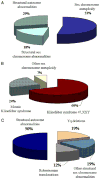Comprehensive 5-year study of cytogenetic aberrations in 668 infertile men
- PMID: 20172548
- PMCID: PMC2969182
- DOI: 10.1016/j.juro.2009.12.004
Comprehensive 5-year study of cytogenetic aberrations in 668 infertile men
Abstract
Purpose: The causes of male infertility are heterogeneous but more than 50% of cases have a genetic basis. Specific genetic defects have been identified in less than 20% of infertile males and, thus, most causes remain to be elucidated. The most common cytogenetic defects associated with nonobstructive azoospermia are numerical and structural chromosome abnormalities, including Klinefelter syndrome (47,XXY) and Y chromosome microdeletions. To refine the incidence and nature of chromosomal aberrations in males with infertility we reviewed cytogenetic results in 668 infertile men with oligozoospermia and azoospermia.
Materials and methods: High resolution Giemsa banding chromosome analysis and/or fluorescence in situ hybridization were done in 668 infertile males referred for routine cytogenetic analysis between January 2004 and March 2009.
Results: The overall incidence of chromosomal abnormalities was about 8.2%. Of the 55 patients with abnormal cytogenetic findings sex chromosome aneuploidies were observed in 29 (53%), including Klinefelter syndrome in 27 (49%). Structural chromosome abnormalities involving autosomes (29%) and sex chromosomes (18%) were detected in 26 infertile men. Abnormal cytogenetic findings were observed in 35 of 264 patients (13.3%) with azoospermia and 19 of 365 (5.2%) with oligozoospermia.
Conclusions: Structural chromosomal defects and low level sex chromosome mosaicism are common in oligozoospermia cases. Extensive cytogenetic assessment and fluorescence in situ hybridization may improve the detection rate in males with oligozoospermia. These findings highlight the need for efficient genetic testing in infertile men so that couples may make informed decisions on assisted reproductive technologies to achieve parenthood.
Copyright (c) 2010 American Urological Association Education and Research, Inc. Published by Elsevier Inc. All rights reserved.
Figures



Similar articles
-
The association between the two more common genetic causes of spermatogenic failure: a 7-year retrospective study.Asian J Androl. 2020 Nov-Dec;22(6):642-648. doi: 10.4103/aja.aja_13_20. Asian J Androl. 2020. PMID: 32362598 Free PMC article.
-
Chromosomal abnormalities and Y chromosome microdeletions in infertile men with azoospermia and oligozoospermia in Eastern China.J Int Med Res. 2020 Apr;48(4):300060519896712. doi: 10.1177/0300060519896712. Epub 2019 Dec 29. J Int Med Res. 2020. PMID: 31885309 Free PMC article.
-
Cytogenetic and Y chromosome microdeletion screening studies in infertile males with Oligozoospermia and Azoospermia in Southeast Turkey.J Assist Reprod Genet. 2008 Nov-Dec;25(11-12):559-65. doi: 10.1007/s10815-008-9272-8. Epub 2008 Oct 25. J Assist Reprod Genet. 2008. PMID: 18953646 Free PMC article.
-
Chromosome abnormalities in sperm from infertile men with normal somatic karyotypes: oligozoospermia.Cytogenet Genome Res. 2005;111(3-4):347-51. doi: 10.1159/000086909. Cytogenet Genome Res. 2005. PMID: 16192714 Review.
-
Clinical implications of Y chromosome microdeletions among infertile men.Best Pract Res Clin Endocrinol Metab. 2020 Dec;34(6):101471. doi: 10.1016/j.beem.2020.101471. Epub 2020 Nov 5. Best Pract Res Clin Endocrinol Metab. 2020. PMID: 33214080 Review.
Cited by
-
Copy-number analysis of Y-linked loci in young men with non-obstructive azoospermia: Implications for the rarity of early onset mosaic loss of chromosome Y.Reprod Med Biol. 2020 Mar 2;19(2):178-181. doi: 10.1002/rmb2.12321. eCollection 2020 Apr. Reprod Med Biol. 2020. PMID: 32273824 Free PMC article.
-
Human spermatogenic failure purges deleterious mutation load from the autosomes and both sex chromosomes, including the gene DMRT1.PLoS Genet. 2013 Mar;9(3):e1003349. doi: 10.1371/journal.pgen.1003349. Epub 2013 Mar 21. PLoS Genet. 2013. PMID: 23555275 Free PMC article.
-
Lower total motile count is associated with smaller historic intergenerational family size: a pedigree analysis from the Utah Population Database.J Assist Reprod Genet. 2021 May;38(5):1207-1213. doi: 10.1007/s10815-021-02115-2. Epub 2021 Feb 24. J Assist Reprod Genet. 2021. PMID: 33629176 Free PMC article.
-
Karyotype analysis in large-sample infertile couples living in Central China: a study of 14965 couples.J Assist Reprod Genet. 2013 Apr;30(4):547-53. doi: 10.1007/s10815-013-9964-6. Epub 2013 Mar 9. J Assist Reprod Genet. 2013. PMID: 23474860 Free PMC article.
-
UBE2B mRNA alterations are associated with severe oligozoospermia in infertile men.Mol Hum Reprod. 2013 Jun;19(6):388-94. doi: 10.1093/molehr/gat008. Epub 2013 Jan 31. Mol Hum Reprod. 2013. PMID: 23378580 Free PMC article.
References
-
- Report OTA: Infertility: Medical and Social Choices OTA-BA-358. Washington, D.C.: United States Congress, Office of Technology Assessment, United States Government Printing Office; 1988.
-
- Abma JC, Chandra A, Mosher WD, et al. Fertility, family planning, and women's health: new data from the 1995 National Survey of Family Growth. Vital Health Stat. 1997;23:1. - PubMed
-
- Report on the Optimal Evaluation of the Infertile Male. American Urological Association Best Practice Statement and American Society of Reproductive Medicine Practice Committee Report. Linthicum Maryland: American Urological Association; 2001. pp. 1–14.
-
- Evaluation of the azoospermic male. Practice Committee of American Society for Reproductive Medicine in Collaboration With Society for Male Reproduction and Urology. Fertil Steril. 2008;90:S74. - PubMed
Publication types
MeSH terms
Grants and funding
LinkOut - more resources
Full Text Sources
Medical

